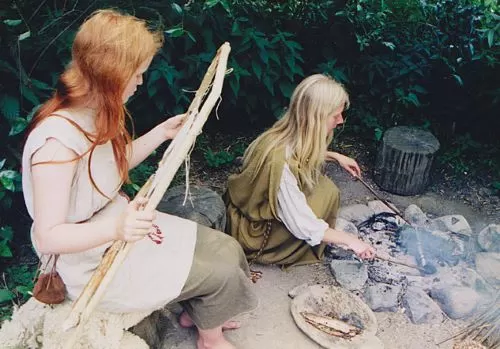The Dawn of Belief: Spiritual Landscapes of the Prehistoric World
The impulse to comprehend existence, to commune with the unseen, and to structure life around a framework of belief is a fundamental human trait. Long before recorded history, this impulse manifested in the complex spiritual and religious practices of prehistoric peoples. While their specific doctrines are lost to time, a compelling narrative of their beliefs emerges from the archaeological record. Through an examination of mortuary rituals, symbolic art, and monumental architecture, we can trace the evolution of spiritual thought from the animistic world of Paleolithic hunter-gatherers to the structured, communal religions of Neolithic societies. This journey reveals not only the dawn of religion but also the cognitive and social transformations that defined early humanity.
The Inner World of the Paleolithic: Animism, Shamanism, and Death
The spiritual life of the Upper Paleolithic (c. 50,000–12,000 BCE) was deeply interwoven with the natural world, a reality reflected in practices of animism, shamanism, and elaborate burial customs. Animism, the belief that spirits inhabit all elements of the natural world, likely formed the basis of their cosmology. [1] This worldview is powerfully expressed in the cave art of sites like Lascaux and Altamira, where magnificent animal figures dominate deep, sacred spaces. [1] More than mere decoration, this art is widely interpreted as having a profound religious purpose. [1] Leading theories propose they were central to shamanic rituals, where practitioners entered altered states of consciousness to communicate with the spirit world. [2] Evidence for this includes the frequent depiction of therianthropes—hybrid human-animal figures, such as the famous “Sorcerer” of Trois-Frères—which are thought to represent shamans mid-transformation. [3][4] These rituals, potentially involving chanting or psychoactive substances, allowed shamans to act as intermediaries, healers, and spiritual guides for their communities. [2][5] The treatment of the dead provides the most concrete evidence of a belief in an afterlife. [1] Middle Paleolithic burials were often simple, but by the Upper Paleolithic, they became increasingly complex. [1][6] At the 34,000-year-old site of Sungir in Russia, individuals were interred with thousands of mammoth-ivory beads and other valuable objects, an immense investment signifying a belief in a continued existence beyond death. [1] The common use of red ochre pigment in these graves is thought to symbolize blood and the life force, further reinforcing the concept of death as a transition rather than an end. [1]
The Neolithic Shift: Agriculture, Ancestors, and Fertility
The Neolithic Revolution (c. 12,000 BCE) marked a fundamental shift in human society, and with it, a transformation in religious practice. [7][8] As nomadic hunter-gatherer lifestyles gave way to settled agricultural communities, spiritual focus moved from the wild animal spirits of the Paleolithic to the land, the cycle of seasons, and lineage. [9][10] This gave rise to one of the most significant religious developments of the era: ancestor worship. [8][9] For sedentary societies, ancestors provided a crucial link to the land and a source of communal identity and authority. This practice is vividly demonstrated by the plastered skulls found at sites like Jericho and ‘Ain Ghazal, dating back to the 7th millennium BCE. [11] Here, the skulls of the deceased were removed, covered in plaster to recreate lifelike features, and kept within the home, presumably as objects of veneration. [11][12] This ritual suggests a belief that ancestors remained active members of the community, capable of influencing the fortunes of the living. [11][13] Alongside this focus on lineage, the dependence on agriculture fostered the growth of fertility cults. [9] Numerous female figurines with exaggerated sexual features have been found across Neolithic sites, interpreted as representations of a mother goddess or symbols intended to ensure the fertility of the land, livestock, and people. [9][14]
Monumental Faith: Collective Ritual and Cosmic Order
The culmination of Neolithic religious development was the construction of monumental architecture, an endeavor that required immense social organization and a powerful, shared ideology. [7] The most staggering example is Göbekli Tepe in southeastern Turkey, which radically altered our understanding of the origins of religion. [15] Dating to c. 9600 BCE, it is the world’s oldest known temple, built not by settled farmers but by hunter-gatherers. [15][16] This vast ceremonial complex, with its massive, T-shaped limestone pillars intricately carved with animals, proves that complex, organized religion could precede permanent settlement and agriculture. [15][17] The site was likely a regional gathering place for sacred rituals, feasts, and perhaps funerary rites, uniting disparate groups under a common belief system. [16][18] Thousands of years later, this tradition of megalithic construction reached a new zenith in Western Europe with monuments like Stonehenge. [19] Built in stages from around 3000 BCE, Stonehenge was a sophisticated temple aligned with the solar calendar, marking the summer and winter solstices. [19][20] It was also a major burial ground, used as a cremation cemetery for centuries, making it the largest of its kind in 3rd millennium BCE Britain. [21][22] The presence of hundreds of human remains, some of whom originated from as far as Wales, suggests Stonehenge was a sacred ancestral monument, a “domain of the dead” that formed the heart of a vast ritual landscape. [21][22]
The spiritual journey of prehistoric humanity reflects a continuous and evolving effort to impose meaning on the world. From the personal, trance-induced visions of Paleolithic shamans to the massive, socially unifying temple complexes of the Neolithic, the archaeological record is a testament to this enduring quest. While the specific gods and myths are beyond our reach, the material evidence of their faith—painted on cave walls, buried with the dead, and built in stone—provides a powerful and humbling glimpse into the origins of human belief.



